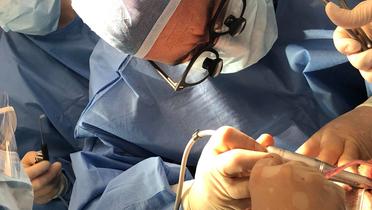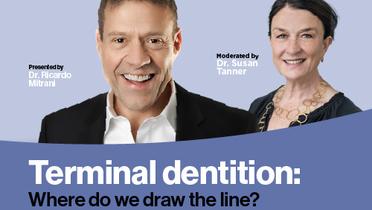-
0
Webinar begins, Alexandra welcomes participants
02:11 - 02:34
-
1
Intro to Dr. Davó’s background
02:35 - 03:10
-
2
Early history of zygomatic implants
03:10 - 05:01
-
3
Rationale for hybrid vs. quad zygoma
05:01 - 09:00
-
4
Quad zygoma definition, workflow, case illustration
09:00 - 15:00
-
5
Scientific evidence, success rates, key publications
15:00 - 23:00
-
6
Intrasinus vs. sinus slot vs. extrasinus (anatomic approach)
23:00 - 32:00
-
7
Digital planning, navigation, guided protocols
32:00 - 40:00
-
8
Complications: sinusitis, recession, fistulas
40:00 - 56:00
-
9
Patient communication, Q&A on implant failures
56:00 - 66:00
-
10
Final thoughts, future studies, course invitations
66:00 - 77:47
- 11 Community questions
Live webinar: Zygomatic Implants: Protocols, Complications, and Long-Term Outcomes
Video highlights
- High Survival Rates: Multiple studies report 95–98% zygomatic implant survival, even in severe maxillary atrophy.
- Immediate Loading: Critical for patient-centered care; most zygoma protocols emphasize “teeth in 24–48 hours.”
- Quad Zygoma Protocol: Four zygomatic implants to handle the most resorbed maxillae, avoiding lengthy grafts.
- Complication Management: Sinus problems typically managed medically; advanced cases addressed with ENT collaboration.
- Soft Tissue Emphasis: Thick soft tissue coverage around the implant’s coronal portion is more crucial than residual alveolar bone height.
- Future Innovations: Navigation and digital workflows can flatten the learning curve and democratize the technique.
In the FOR Webinar on “Zygomatic Implants for the Extremely Resorbed Maxilla,” Dr. Ruben Davó shares various strategies, insights, and techniques on how to manage complex edentulous cases where patients have minimal or no alveolar bone remaining in the maxilla. He provides us with information on the key surgical approaches—such as the Quad Zygoma concept—and emphasizes how to prevent and address potential complications over the long term.
Dr. Davó opens the webinar by noting that many of the challenging edentulous maxillary cases we see today often stem from previous implant failures or from patients who simply have severe bone resorption and are unable to receive conventional implants. He remarks that in his experience, the number of such patients has grown over the last two decades, underscoring the need for predictable, evidence-based solutions. He explains that zygomatic implants, anchored in the dense zygoma bone, can circumvent the lack of maxillary alveolar bone and offer a stable platform for immediate loading. As he points out, these implants bring a patient-centered approach that allows for rapid functional rehabilitation—often within 24–48 hours—restoring quality of life in a short timeframe.
Dr. Davó presents four areas of focus:
- Hybrid Zygoma (Combination of Conventional and Zygomatic Implants)
- Quad Zygoma (Four Zygomatic Implants)
- Different Surgical Pathways (Intrasinus vs. Extrasinus)
- Common Complications and Their Management
1. Hybrid Zygoma: Combining Conventional and Zygomatic Implants
The first concept Dr. Davó introduces is the hybrid zygoma approach, which is indicated when there is still some anterior maxillary bone available to place two or more conventional implants. Usually, two zygomatic implants are placed in the posterior, while conventional implants are used in the front. He shares a clinical case of a patient with enough residual bone in the anterior region to position standard fixtures but an extremely resorbed posterior maxilla. In such situations, the zygomatic implants ensure posterior support, and immediate loading is typically performed to stabilize the arch promptly.
Dr. Davó emphasizes that this approach spares patients from lengthier grafting or sinus lift procedures. At the same time, it capitalizes on whatever alveolar bone is left in the anterior maxilla. The ultimate outcome is a full-arch prosthesis with cross-arch stabilization, delivering acceptable function and esthetics in a matter of days or even hours.
2. Quad Zygoma: Four Zygomatic Implants
The second topic, and often the most prominent in these advanced cases, is the Quad Zygoma concept. Dr. Davó describes that in situations where the patient has little to no anterior alveolar bone at all, four zygomatic implants—two in each zygoma—can be employed to anchor the full-arch prosthesis. He showcases dramatic clinical photographs of patients with virtually zero maxillary bone who were treated successfully with this technique.
Dr. Davó shares that historically, extensive bone grafts or sinus augmentations were the only options for these patients. However, with Quad Zygoma, the treatment can be completed much faster and with predictable success rates, often reaching 95–98% or higher over the long term. In one of his highlighted clinical cases, a patient who had multiple failed conventional implants due to peri-implantitis was immediately rehabilitated with a Quad Zygoma approach and reported substantial improvement in both function and self-confidence.
3. Different Surgical Pathways: Intrasinus vs. Extrasinus
The third point of discussion centers around the distinct pathways for placing zygomatic implants: intrasinus vs. extrasinus (also referred to as sinus slot or anatomically guided approach). Dr. Davó highlights that in the original intrasinus technique, the implant body passes through the sinus cavity and often emerges more palatally. While effective, this can predispose patients to certain sinus-related issues or to a less ideal prosthetic emergence.
By contrast, the extrasinus or sinus slot approach aims to situate the zygomatic implant along the lateral wall of the maxilla, avoiding deep penetration into the sinus. This helps reduce palatal emergence and can minimize certain complications. However, Dr. Davó cautions that the key factor for success is proper handling of the sinus membrane. Whether the implant is positioned intrasinus or extrasinus, any inadvertent damage to the Schneiderian membrane can lead to sinus problems. He underlines that careful preoperative imaging and thorough knowledge of anatomical landmarks are essential for safe placement and to preserve sinus health.
4. Common Complications and Their Management
Finally, Dr. Davó addresses complications that may arise with zygomatic implants and the ways to manage them effectively:
• Sinusitis or Sinus-Related Issues
Dr. Davó notes that in about 10–12% of cases, patients can experience sinus discomfort or infections postoperatively. In most instances, these respond well to antibiotics. In rare scenarios, functional endoscopic sinus surgery (FESS) may be needed. He underscores that prior sinus conditions—like septal deviations—can predispose the patient to these complications, so collaboration with an ENT specialist is vital.
• Mucosal Recession
Where alveolar bone is extremely thin, some recession of the soft tissues around the coronal aspect of the zygomatic implants can occur over time. Dr. Davó points out that ensuring thick, healthy soft tissue coverage from the outset is paramount. He mentions small local flaps or even adipose flaps to rebuild coverage if recession becomes symptomatic or affects esthetics.
• Facial Fistulas and Apex Protrusion
Extremely rare, but Dr. Davó shows that if the implant apex is left protruding beyond the zygoma’s external cortex, it can lead to subcutaneous inflammation or abscess formation. The solution is careful primary placement or, if it occurs, an apical resection coupled with local cleaning.
• Implant Failures
While rare, Dr. Davó indicates that in cases where a zygomatic implant does fail, it is often feasible to place a new one by angling differently into the zygomatic bone. Since the zygoma is fairly wide, alternative angulations typically exist, and patients can be re-treated successfully, sometimes even adding a pterygoid implant if the situation requires added support.
Throughout his explanations, Dr. Davó stresses that the risk of failure or sinus complications is relatively low, and that with proper technique and patient selection, zygomatic implants—especially in the Quad Zygoma format—prove highly reliable, with well-documented long-term success rates.
He concludes the webinar with the reminder that immediate loading is the key driver for positive patient outcomes in these challenging cases. Patients benefit psychologically and functionally from having their prosthesis delivered promptly. Looking ahead, Dr. Davó believes that 3D navigation and advanced digital workflows will further refine and standardize the procedure, enabling more clinicians worldwide to offer zygomatic implant solutions. He invites participants to continue exploring educational resources and hands-on training opportunities through the Foundation for Oral Rehabilitation, underlining the importance of skillful execution to achieve predictable, life-changing results for patients with severely resorbed maxillae.
References
[1] Hirsch JM, Öhrnell LO, Henry PJ, Andreasson L, Brånemark PI, Chiapasco M, Gynther G, Finne K, Higuchi KW, Isaksson S, Kahnberg KE, Malevez C, Neukam FW, Sevetz E, Urgell JP, Widmark G, Bolind P. A clinical evaluation of the Zygoma fixture: one year of follow-up at 16 clinics. J Oral Maxillofac Surg. 2004 Sep;62(9 Suppl 2):22-29. doi: 10.1016/j.joms.2004.06.030. PMID: 15332178.
Link: https://doi.org/10.1016/j.joms.2004.06.030
[2] Brånemark PI, Gröndahl K, Öhrnell LO, Nilsson P, Petruson B, Svensson B, Engstrand P. Zygoma fixture in the management of advanced atrophy of the maxilla: technique and long-term results. Scand J Plast Reconstr Surg Hand Surg. 2004;38(2):70-85. doi: 10.1080/02844310310023918. PMID: 15202664.
Link: https://doi.org/10.1080/02844310310023918
[3] Malevez C, Abarca M, Durdu F, Daelemans P. Clinical outcome of 103 consecutive zygomatic implants: a 6–48 months follow-up study. Clin Oral Implants Res. 2004 Feb;15(1):18-22. doi: 10.1046/j.1600-0501.2003.00985.x. PMID: 15005100.
Link: https://doi.org/10.1046/j.1600-0501.2003.00985.x
[4] Davó R, Malevez C, Rojas J. Immediate function in the atrophic maxilla using zygoma implants: a preliminary study. J Prosthet Dent. 2007 Jun;97(6 Suppl):S44-S51. doi: 10.1016/S0022-3913(07)60007-9. PMID: 17618933.
Link: https://doi.org/10.1016/S0022-3913(07)60007-9
[5] Duarte LR, Nary Filho H, Francischone CE, Peredo LG, Brånemark PI. The establishment of a protocol for the total rehabilitation of atrophic maxillae employing four zygomatic fixtures in an immediate loading system – a 30-month clinical and radiographic follow-up. Clin Implant Dent Relat Res. 2007 Dec;9(4):186-196. doi: 10.1111/j.1708-8208.2007.00046.x. PMID: 18031440.
Link: https://doi.org/10.1111/j.1708-8208.2007.00046.x
[6] Davó R, Malevez C, López-Orellana C, Pastor-Beviá F, Rojas J. Sinus reactions to immediately loaded zygoma implants: a clinical and radiological study. Eur J Oral Implantol. 2008 Spring;1(1):53-60. PMID: 20467644.
Link: https://pubmed.ncbi.nlm.nih.gov/20467644/
[7] Stiévenart M, Malevez C. Rehabilitation of totally atrophied maxilla by means of four zygomatic implants and fixed prosthesis: a 6–40-month follow-up study. Int J Oral Maxillofac Surg. 2010 Apr;39(4):358-363. doi: 10.1016/j.ijom.2010.01.009. PMID: 20171057.
Link: https://doi.org/10.1016/j.ijom.2010.01.009
[8] Davó R, Pons O, Rojas J, Carpio E. Immediate function of four zygomatic implants: a 1-year report of a prospective study. Eur J Oral Implantol. 2010 Winter;3(4):323-334. PMID: 21180685.
Link: https://pubmed.ncbi.nlm.nih.gov/21180685/
[9] Davó R, Malevez C, Pons O. Immediately loaded zygomatic implants: a 5-year prospective study. Eur J Oral Implantol. 2013 Spring;6(1):39-47. PMID: 23513201.
Link: https://pubmed.ncbi.nlm.nih.gov/23513201/
[10] Davó R, Pons O. Prostheses supported by four immediately loaded zygomatic implants: a 3-year prospective study. Eur J Oral Implantol. 2013 Autumn;6(3):263-269. PMID: 24179980.
Link: https://pubmed.ncbi.nlm.nih.gov/24179980/
[11] Davó R, Pons O. 5-year outcome of cross-arch prostheses supported by four immediately loaded zygomatic implants: a prospective case series. Eur J Oral Implantol. 2015 Summer;8(2):169-174. PMID: 26021227.
Link: https://pubmed.ncbi.nlm.nih.gov/26021227/
[12] Esposito M, Davó R, Marti-Pages C, Ferrer-Fuertes A, Barausse C, Pistilli R, Ippolito DR, Felice P. Immediately loaded zygomatic implants vs conventional dental implants in augmented atrophic maxillae: 4 months post-loading results from a multicentre randomised controlled trial. Eur J Oral Implantol. 2018;11(1):11-28. PMID: 29557398.
Link: https://pubmed.ncbi.nlm.nih.gov/29557398/
[13] Davó R, Felice P, Pistilli R, Barausse C, Marti-Pages C, Ferrer-Fuertes A, Ippolito DR, Esposito M. Immediately loaded zygomatic implants vs conventional dental implants in augmented atrophic maxillae: 1-year post-loading results from a multicentre randomised controlled trial. Eur J Oral Implantol. 2018;11(2):145-161. PMID: 29806663.



